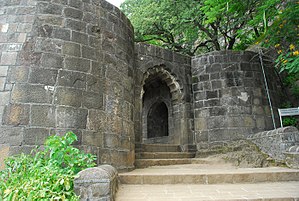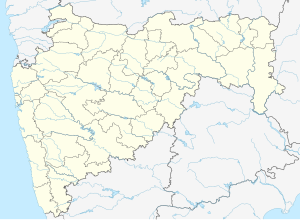Shivneri
| Shivneri | |
|---|---|
| शिवनेरी | |
| Junnar, Pune District, Maharashtra | |
 |
|
|
Shivneri in Maharashtra
|
|
| Coordinates | 19°11′56″N 73°51′34″E / 19.1990°N 73.8595°E |
| Type | monument building |
| Site information | |
| Owner |
|
| Controlled by |
|
| Open to the public |
Yes |
Shivneri Fort is a 17th-century military fortification located near Junnar in Pune district in Maharashtra, India. It is the birthplace of Shivaji, the founder of Maratha Empire.
Shivneri is known to be a place of Buddhist dominion from the 1st century AD. The caves, rock-cut architecture and water system indicate presence of habitation from the 1st century. Shivneri got its name as it was under the possession of the Yadavas of Devagiri. This fort was mainly used to guard the old trading route from Desh to the port city of Kalyan. The place passed on to the hands of Bahami kings after the weakening of Delhi Sultanate during the 15th century. In 1595, Maratha chief Maloji Bhosale, the grandfather of Shivaji, was enabled by Bahami king Bahadur Nizam Shah II and gave him the inter-alia Shivner and Chakan. Chhatrapati Shivaji was born at the fort on 19 February 1630 (some accounts place it 1627), and spent his childhood there. Inside the fort is a small temple dedicated to the goddess Shivai Devi, after whom Shivaji was named. The English traveller Fraze visited the fort in 1673 and found it invincible. According to his accounts the fort was well-stocked to feed thousand families for seven years. He also made a mention that the fort was then governed by a Brahmin turned Muslim. The fort was under the control of the Mughals after the Marathas and Sahu demanded it back in 1716. They regained the fort in 1762 and became a part of Ragunatha Rao. The fort came under the control of the British Rule in 1820 after the Third Anglo-Maratha War.
Shivneri is a hill fort having a triangular shape and has its entrance from the South-west side of the hill.Apart from the main gate there is an entrance to the fort from side called locally as the chain gate, where in one has to hold chains to climb up to the fort gate. The fort extends up to 1 mi (1.6 km) with seven spiral well-defended gates. There are mud walls all around the fort. Inside the fort, the major buildings are the prayer hall, a tomb and a mosque. There is an overhanging where executions took place. There are many gates structures protecting this fort. Mana Daravaja is one of the many gates of the fort.
...
Wikipedia

